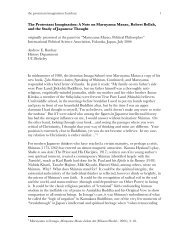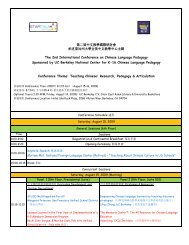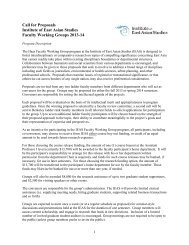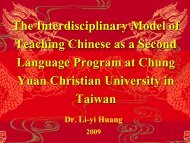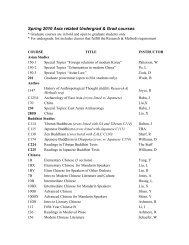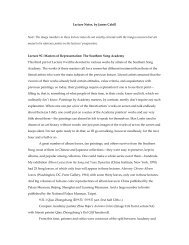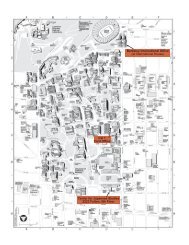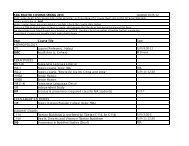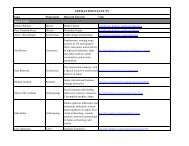Third Edition Spring 2013 - Institute of East Asian Studies, UC ...
Third Edition Spring 2013 - Institute of East Asian Studies, UC ...
Third Edition Spring 2013 - Institute of East Asian Studies, UC ...
Create successful ePaper yourself
Turn your PDF publications into a flip-book with our unique Google optimized e-Paper software.
<strong>of</strong> Buddhist temples. Each individual living in a Japanese town wasrequired to register with their local priest, while a ledger <strong>of</strong> thisregistry was kept in the local temple. If an individual moved, theirmove would be recorded and their new domicile would be enteredinto the record <strong>of</strong> their new local priest. Whenever a family experienceda birth or a death, this too would be recorded in the templeledgers.The second part <strong>of</strong> this partnership involved the Tokugawagovernment’s attempts to police sectarian law by providingsecular punishments for sectarian law violations. If a priest werecaught breaking one <strong>of</strong> their precepts (especially the ones regardingsexual conduct with women) he was to be beaten, stripped<strong>of</strong> his robe, forcibly laicized, and quite literally thrown out <strong>of</strong> thetemple. The punishment for these crimes sometimes changed, sothat one recorded forced laicization involved the convicted monkbeing forced to crawl around his temple three times on his handsand knees while practically naked, and another speaks <strong>of</strong> crucifixion.15 The purpose, however, was always the same, namely to keepthe sangha free <strong>of</strong> individuals who would break their vows whileenjoying their elevated social status. At first, the secular punishmentsfor sectarian crimes may appear harsh. However, becominga priest in Edo Japan was no small matter. Indeed, once one wasordained, the initiate’s name was changed to a Buddhist name, andall connections to their previous life were wiped away, includingclass affiliation. They ceased to use their secular names and wererecorded in a second, separate register unconnected to the register<strong>of</strong> common subjects. Jaffe writes <strong>of</strong> the special privileges affordedthe clergy:When in attendance at the local magistrate’s <strong>of</strong>fice, Buddhistclerics were allowed to sit one level higher than commoners. …Theywould be allowed to have an assigned seat at the daimyo’s residenceduring his New Year celebration. In recognition <strong>of</strong> their role outside<strong>of</strong> secular society, the clergy were placed primarily under the control<strong>of</strong> their…head temple. 1615 Jaffe p. 2316 Jaffe p. 17Thus, Buddhism was brought into the administrative circle<strong>of</strong> the Tokugawa regime. This high status and deep connection tothe state was visible on many levels besides the temple registry duties<strong>of</strong> monks. Sect power was measured, in part, by the respect andstatus bestowed upon by the shogunate. Leaders <strong>of</strong> sects wouldgrudgingly compare notes on how each <strong>of</strong> them were received bythe shogun, taking <strong>of</strong>fense if they were required to walk certaindistances rather than being allowed to ride in the palanquins to theentrance <strong>of</strong> the shogun’s chambers.During this long period <strong>of</strong> stability, the Buddhist communitywas <strong>of</strong>ten the subject <strong>of</strong> harsh edicts from the bakufu, especiallyregarding the problem <strong>of</strong> secret marriages resulting in hereditarypassing <strong>of</strong> temple abbothood. Dubbed nikujisaitai ( 肉 食 妻 帯 , literally“meat eating and marriage”) due to its connection to the breaking<strong>of</strong> the vow against meat eating, it was considered a problem byboth Buddhist leaders and the shogunate. The concern <strong>of</strong> Buddhistleaders revolved around doctrinal matters, while the shogunatewas concerned primarily with the abuse <strong>of</strong> inheritance laws. Theshogunate took great pains to try and prevent the passing <strong>of</strong> abbothoodfrom father to son, and the Buddhist leadership was morethan happy to accommodate.The fall <strong>of</strong> the shogunate government in 1868 signaled aquick end to the favored status <strong>of</strong> Buddhism. Due in part to theideological underpinnings <strong>of</strong> the Meiji Restoration, Buddhism soonfound itself under attack from both the laity and members <strong>of</strong> thegovernment as an “old evil” <strong>of</strong> the past, with the understandingthat Shintoism would replace it. Jaffe writes:The Meiji Restoration temporarily brought…hard line Shinto andNativist scholars…to positions <strong>of</strong> power in the newly established Department<strong>of</strong> Rites. Seeking to provide an ideological foundation forthe new government, Meiji leaders distanced themselves from theBuddhist institutions that had given support to the Tokugawa government.17Indeed, the fact that Buddhism had been a pillar within theTokugawa government’s power structure was a key reason that the17 Jaffe p. 5895 Robert Bowers Curl Laicization in Japanese Buddhism 96




